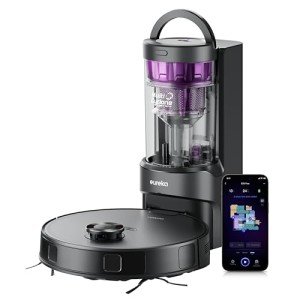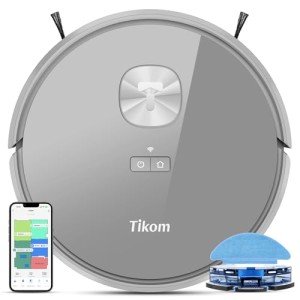10 Of The Top Mobile Apps To Use For Robotic Vacuum Cleaner Best
페이지 정보
Eliza Padbury 작성일25-02-06 12:47본문
 What Makes a Robot Vacuum Cleaner best robot floor cleaner (Wiki.Iurium.Cz)?
What Makes a Robot Vacuum Cleaner best robot floor cleaner (Wiki.Iurium.Cz)?The top robot hoover vacuums have a powerful engine and a sturdy set of bristles or rollers. They also have adequate dustbins and long battery life.
Certain models use smart mapping to create maps of homes. They can be able to pause, recharge and pick up cleaning exactly where they stopped. They can also define no-go zones, and even identify different surfaces.
Object Avoidance
Object detection is a crucial feature for robot vacuums since it allows them to avoid running into small items like socks, toys, cords, or shoes that aren't on the floor, but on furniture. The systems utilize an inbuilt camera to detect objects that appear in an AI database and then teach the vacuum how to avoid them. The Eufy S1 Pro uses a combination of sensors, Robot Vacuum Cleaner Best such as 3D Time of Flight, which sends light pulses into the room to determine distance and depth of objects, and 3D Structured Light, which beams a pattern of light onto the room, analyzing the distortion of light to build a map to avoid obstacles.
Artificial intelligence and visual interpretation are a newer addition to robot obstacle avoidance. They enable robots to better understand and recognize what they come across. This software utilizes two cameras to observe the world and analyze it in real-time. The ECOVACS DEEBOT uses this software to detect up to 30 different kinds of objects including shoes, cables and pet poop.
Some models use LiDAR for navigation. The technology emits lasers and determines the amount of time it takes for them to bounce off the surfaces around them in order to create a 3-D map. This is able to identify furniture, walls, and even stairs. It may not work well in dim lighting or with reflective or transparent objects.
Whatever sensor or cameras are being used regardless of the camera or sensor, a long battery life is essential to ensure that your robot will be able to complete the entire house without needing to return to its dock to recharge. Find a model that can run for at least 80 minutes or more, depending on the dimensions of your living space.
self vacuum near me-Emptying Bases
Some robot vacuum cleaners feature self-emptying bases, which can reduce the frequency you need to empty your trash. They're considered a premium feature that typically increases the cost of a robot.
The best robots come with bases that are able to hold either bins, or a mov or running out of power during cleaning.
The app serves as a one-stop control center to monitor and schedule tasks. The app allows you to modify the cleaning mode, power and water level of your robotic cleaner. This feature is particularly useful in homes that have multiple flooring types, such as carpet and tile. You can assign the robot the right power and mode to clean each area.
Certain models have cameras built-in that send a live feed to the app. These models are perfect for pet owners and people with small children who wish to monitor the robot as it operates. Other smart robots have sensors that detect when they've reached the edge of a room, and return to their base to dock. This prevents them from taking over the area and ensures that they've cleaned all of the surfaces in your home.
Certain models automatically empty the dustbin and even wash and blow dries its mop heads between cleaning sessions. This minimizes the frequency of manual maintenance and keeps the cleaner performing well for a longer duration. You can also choose models with an extended battery that helps you avoid the hassle of mid-cleaning recharges.
Sensors
Many robot vacuums use sensors to navigate around your home and work their magic on hard floors, such as laminate, wood, and tile as also low pile carpets and area rugs. They are not a replacement to a full-size canister or upright cleaner, but offer excellent suction and a fantastic way to keep your floors clean between deep cleanings.
Sensors assist the robot in navigating your home by spotting obstacles and avoiding falling down stairs. You can also set up physical and virtual "no go" zones by using boundary strips or a virtual walls (like those employed by Eufy) to stop the robot entering specific areas within your home. Some robots have cliff sensors which alert you when your robot is set to run into an obstacle.
The type of navigational system robot employs is determined by your budget robot vacuum and the layout of your home. Some of the most advanced robotic vacuums utilize LiDAR sensors to map and scan the area that ensure accurate navigation. These systems are costly, but provide the most effective results. Budget models with rudimentary navigation bumps are less precise and may miss places. They are great for avoiding major obstacles, but they can still miss dirt in crevices and around baseboards.
Choose a model with an extra-large dust bin as well as an extended battery life. There are models that can dock and recharge, then resume where they were when they left. This can save time. In addition to navigation it is possible to make the most of your robot vacuum by preparing for each cleaning session. Check that all power cables, toys, and other debris is tucked out of the robot’s path and empty the trash bin after each cleaning. Also, clean the sensors and charging ports to keep the robot healthy.
Navigation
The most effective robot vacuums employ mapping technology to create an electronic map of your home prior to the initial cleaning session. It helps them recognize textures, such as carpets and hard floors, and ensures that all areas are thoroughly cleaned. Mapping also prevents your robot from having to clean the same spots which increases efficiency and can reduce battery usage. Many high-end models have the option to save a map of your house for future use which is ideal for homes with larger spaces.
The majority of robotic vacuums have some kind of obstacle avoidance system that stops them from tripping over cords or socks, or shoes. These sensors do not always detect small objects. In the past few years, manufacturers began adding additional sensors to their robots, which allowed them to detect and avoid household objects that standard sensor systems couldn't. These include wall and cliff sensors, which operate by bouncing infrared light beams off surfaces to determine distances.
Some sensors are built directly into the robot base, however, others require being purchased separately. They generally aid the robot vacuum reviews in navigating in a safe manner, avoid falling down steps and avoid clutter. Some models even include anti-drop sensors that will stop the robot from colliding with furniture or walls.
 LiDAR mapping, the most advanced navigation system is a feature that you should look for when buying robot vacuum. This kind of system makes use of a spinning laser sensor mounted on the top of the robot in order to map your home. By bounced infrared beams off furniture and walls it can determine the layout of your room. This helps to plan efficient routes and also clean your entire house.
LiDAR mapping, the most advanced navigation system is a feature that you should look for when buying robot vacuum. This kind of system makes use of a spinning laser sensor mounted on the top of the robot in order to map your home. By bounced infrared beams off furniture and walls it can determine the layout of your room. This helps to plan efficient routes and also clean your entire house.댓글목록
등록된 댓글이 없습니다.

















